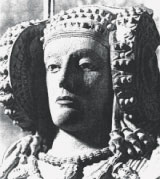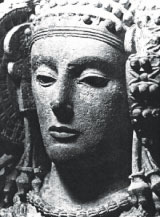The Lady of Elche is a forgery, too
In 2001 we payed another visit to the National Archaeological Museum of Madrid to have a more severe look at the so called Lady of Elche, a marble bust that is some kind of a national deity to Spaniards of all standing. We were disgusted with the all to many hints that it must be a forgery. You can see it easily even if you are not a specialist.

The famous female bust of about life size is titled “prehistoric Iberian sculpture roughly 2500 years old”.
First of all one looks at the mouth, those erotic lips painted faintly red. That is the type of beauty hall mark the higher society loved a century ago. It was exactly this criterium that made me unmask the not less beautiful lady Persephone of Berlin (sorry, “Persephone of Tarento”): a certain aesthetic concept which could be summarized “Jugendstil”.
An easy approach to forgeries made of stone is to look for damaged portions; they usually occur at odd sites, not where you would expect them.
Very seldom a figure is damaged in a way to make it look ugly. In most cases important parts of the face are conserved perfectly. Yet minor damages have to be there to make it look old. Our Lady of Elche has a deep scar (replenished by restauration) at the left cheek right underneath the ear, that is: in a well protected corner, where it could hardly be damaged before nose, lips or eyelids are destroyed. Which they are not.

This is not just suspicious, it is simply impossible.
Then I usually look at the ability of the artist to represent a human figure. Most good artists – those who work openly and tell the truth about the origin of their products – have a certain canon of knowledge.
Forgers instead commit blunt failures. In this case it is the neck of the Lady that is far to thick, the nose is unorganic, the headgear seems invented. Only the jewellery is well copied.
Next step: Have a look at the circumstances of discovery, accompanying finds or witnesses of the excavation. In this Museum they are of easy access. All 300 figurines exhumed along with the Lady of Elche in the Cerro de los Santos (prov. of Alicante) look as if they had been manufactured by one hand, as the accompanying text admits. They do not reveal any development of style nor difference in artistic concept. Facial expressions are described as “archaic or pseudo-archaic” (!). But the archaeologists give them dates that range over five hundred years.
Then there are the other circumstancial evidences as broken edges without necessity, rather provoked by hand. Or that those little heads of men have no neck but small holes where they could be put into busts, but busts were never found.
Some of the figures do remind me of early christian saints, even suggesting romanic style or irish provenance. This can be stated especially of the animal figures. They look most authentic irish.
There existed a figure of a Lady of less perfect form called the “Big Lady of Elche”, easily to be recognized as a forgery. But on August 4th, 1897, the now known Lady of Elche was found at La Alcudia and quickly exported to Paris and exposed in the Louvre where she was applauded by the public. She was in 1841 recalled and recovered by the Spanish public as the “Moorish Queen”. By this international transfer the sculpture became famous and was accepted as authentic, together with other figures from Cerro de los Santos which had been considered forgeries by French authorities up to this moment.
As far as literature on the figures is available, the discussion about the age and origin of the figures of Cerro de los Santos was decided a decade ago. An American professor, John F. Mofitt, anounced in 1985 that the Lady of Elche and the other finds are forged. Ten years later he published a book to this extent at the University of Florida with sufficient proof for his thesis.
R. Olmos and T. Tortosa at a Madrid Symposium held in 1996 to this effect have summoned all facts recognizing that the Lady of Elche has been produced by an artist in the 19th century. These books are at sale in the library of the Museum.
So we have two ways of presenting the Iberian past to visitors of the Museum: The highly protected stone statue in its glass case visited by all kind of naïve onlookers from around the world who are ready to believe whatever is told; and books that are presented to a smaller group of people who can read: they are told that the Lady is a fake.
Something wrong with it?
Recently this Lady – although not a catholic virgin and therefore not entitled to any type of adoration – has been washed of all suspicion and prooved to be authentic through a book written by a Spanish priest.
.
Literatur:
Mofitt, John F. (1995): Art Forgery. The Case of the Lady of Elche (Univ. Press of Florida, Gainsville, USA)
Olmos, R. und Tortosa, T. (1996): El caso de la Dama de Elche, más que una divergencia, in: Archivo Español de Arqueologia No. 69. S. 219-226 (Madrid)
(1997): La Dama de Elche. Lecturas desde la diversidad (Madrid)







